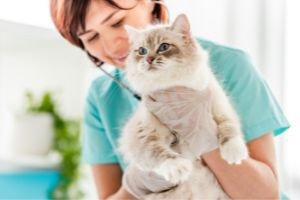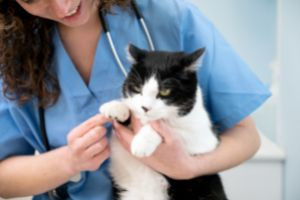Cats are often lauded as the perfect pets: graceful, self-sufficient, affectionate, and wonderfully low-maintenance. Their soothing purrs and soft fur make them cherished companions in millions of homes. However, even the most devoted cat lovers can be challenged by a common feline issue: inappropriate urination, or when your cat is peeing everywhere except in their designated litter box.
As veterinarians specializing in feline care, we understand the frustration and concern that comes with finding cat pee in unexpected places. It’s a frequent complaint we hear: “My cat is peeing on the rug, the laundry, my new handbag, even the bed! I’m at my wit’s end!” You’re not alone. Inappropriate urination is a leading cause of stress for cat owners and a major reason for cats being surrendered to shelters.
 Veterinarian examining a cat for potential urinary tract problems, a common feline health concern.
Veterinarian examining a cat for potential urinary tract problems, a common feline health concern.
The Frustrating Reality of Feline Urinary Issues
What makes inappropriate urination so vexing is its multifaceted nature. It often affects seemingly healthy, young cats and can feel like it appears without warning. There isn’t always a clear cause, prevention isn’t foolproof, and a definitive cure can be elusive. This issue is not just about property damage and unpleasant odors; it can be emotionally draining for everyone involved and, in some cases, indicative of serious underlying health problems.
Consider this: studies estimate that at any given time, a significant percentage of cats are suffering from urinary tract disorders. If you’re dealing with a cat peeing outside the litter box, remember you’re not alone. It’s a widespread problem, and it’s crucial to approach it with understanding and a systematic approach to find a solution. Resist the urge to attribute this behavior to spite or anger. Cats aren’t capable of these emotions in the way humans are. Instead, inappropriate urination is usually a sign that something is wrong, either medically or emotionally.
Ruling Out Medical Causes First: A Veterinary Necessity
Important Fact: Bacterial infections are surprisingly not the primary culprit in most cases of inappropriate urination in cats.
When faced with a cat peeing outside the litter box, many people immediately assume a urinary tract infection (UTI). This is a natural assumption, as bladder infections are common in humans. However, in the feline world, UTIs are less frequent than you might think. Studies show that bacterial UTIs account for a small percentage of feline lower urinary tract issues. Similarly, while bladder crystals (like struvite or oxalate) can cause irritation and influence urination habits, they are not the sole explanation in the majority of cases.
This means that in a large number of cats exhibiting urinary problems, there’s no infection, no crystals, no tumors – essentially, no easily identifiable physical cause. The bladder simply becomes inflamed and irritated, leading to discomfort and altered urination patterns. This condition is often referred to by various names, including Feline Lower Urinary Tract Disease (FLUTD), Feline Idiopathic Cystitis (FIC), or Feline Interstitial Cystitis. “Idiopathic” means the cause is unknown.
It’s crucial to understand that while antibiotics and special diets are often prescribed for cats with urinary issues, they are not always the quick fix you might hope for. These treatments are frequently used to address potential contributing factors or secondary issues, but they may not resolve the underlying problem, especially if it’s not bacterial or crystal-related. Recurrence is also common, highlighting the chronic nature of feline urinary tract issues.
So, what triggers this bladder irritation? The honest answer is, often, we don’t know definitively. The feline urinary system is complex, and these conditions are not fully understood. And why does bladder irritation lead to peeing outside the litter box? That too remains a mystery. It’s as if cats, when experiencing bladder discomfort, seek to communicate their distress by urinating in places that are noticeable to their owners.
The essential first step when your cat starts peeing outside the litter box is a veterinary visit. A veterinarian is not just there to prescribe medication; they are there to act as a detective, systematically investigating the potential causes and guiding you towards the best course of action. Approach the appointment with an open mind, understanding that the solution may not be straightforward and will require patience and collaboration with your vet.
Diagnostic Steps Your Veterinarian Will Take
To rule out medical reasons for your cat’s inappropriate urination, your veterinarian will likely perform a series of diagnostic tests. These standard procedures are essential to ensure that any underlying health issues are identified and addressed promptly:
- Complete Physical Examination: A thorough physical exam allows the vet to assess your cat’s overall health, checking for any signs of pain, discomfort, or abnormalities that could be contributing to the problem.
- Urinalysis: This is a critical test that analyzes your cat’s urine. It can detect signs of infection (although, as mentioned, bacterial infections are less common), crystals, blood, and other abnormalities that could indicate a medical issue.
- Bacterial Urine Culture: If a urinary tract infection is suspected based on the urinalysis, a urine culture is performed to identify the specific type of bacteria present. This allows for targeted antibiotic treatment if necessary.
- Bladder Imaging (X-rays or Ultrasound): Imaging techniques like X-rays or ultrasound can help visualize the bladder and urinary tract. They can rule out bladder stones, tumors, or other structural abnormalities that might be causing the urination problems.
These tests help your veterinarian systematically eliminate medical conditions as the primary cause of your cat’s inappropriate urination before considering behavioral factors. This methodical approach is crucial because treating a behavioral issue when a medical problem exists will not be effective and could delay necessary medical care.
When It’s Behavioral: Understanding Cat Anxiety
Once medical causes have been ruled out, the diagnosis may point to a behavioral issue. It’s important to reiterate that cats do not urinate outside the litter box out of spite, anger, or jealousy. Attributing human emotions to feline behavior is a common misconception.
Instead, a cat peeing outside the litter box for behavioral reasons is most likely experiencing anxiety or stress. To understand this, you need to think like a cat, to see the world from their perspective. What might be causing your cat to feel anxious or insecure in their environment?
 An anxious cat at the veterinary clinic, highlighting the stress that can contribute to inappropriate urination in felines.
An anxious cat at the veterinary clinic, highlighting the stress that can contribute to inappropriate urination in felines.
Addressing Behavioral Inappropriate Urination
Why does anxiety manifest as inappropriate urination in cats? The exact mechanism isn’t fully understood, but it’s clear that stress can significantly impact a cat’s urinary habits. Treating behavioral inappropriate urination focuses on reducing stress and creating a more secure and comfortable environment for your cat. This can involve several strategies, ranging from environmental modifications to, in some cases, medication.
Key Principles for Managing Litter Box Issues:
1. Litter Box Quantity: Independence and Choice
Cats are independent creatures, and in multi-cat households, this independence extends to litter box preferences. Each cat may prefer a specific box and can be territorial about “their” space. A general rule of thumb is to have one more litter box than the number of cats in your home. This provides ample options and reduces competition for resources.
2. Safety and Accessibility: No Ambush Zones
Safety is paramount for cats. Every cat should have easy and safe access to a litter box, free from intimidation or harassment from other pets. Imagine being a cat and having to run a gauntlet past another cat just to use the bathroom! This is a significant source of stress.
- Location, Location, Location: Place litter boxes in locations where cats feel safe and secure. Avoid high-traffic areas or places where they might feel trapped.
- Escape Routes: Ensure there are multiple escape routes from the litter box area so a cat doesn’t feel cornered.
- Monitor Interactions: Observe your cats’ behavior around the litter boxes. Is one cat blocking access or ambushing another cat entering or exiting the box?
- Separate Resources: If possible, place litter boxes in different rooms or on different floors to minimize inter-cat conflict.
3. Privacy and Quiet Zones
Cats value privacy, especially when they are in a vulnerable position like using the litter box. Place litter boxes in quiet, low-traffic areas where your cat can feel undisturbed.
- Avoid Loud Appliances: Do not place litter boxes near noisy appliances like washing machines or furnaces.
- Consider Bathrooms or Closets: Bathrooms or quiet closets can be good locations, provided they are easily accessible to the cat.
- Covered vs. Uncovered Boxes: Some cats prefer covered litter boxes for added privacy, while others feel trapped by them. Observe your cat’s preference. If you are using a covered box and are experiencing issues, try removing the cover to see if it makes a difference.
4. Cleanliness: A Cat’s Fastidious Nature
Cats are meticulous groomers and highly value cleanliness. They don’t want to step into a soiled litter box, especially one with lingering urine or feces.
- Scoop Frequently: Scoop litter boxes at least twice daily to remove urine clumps and feces.
- Regular Deep Cleaning: Empty the entire litter box weekly (or more frequently if needed). Scrub the box with soap and water (avoid harsh chemicals or strong scents), and refill with fresh litter.
- More Boxes, Less Soiled Boxes: Having enough litter boxes helps prevent them from becoming overly soiled quickly, especially in multi-cat homes.
5. Consistency: Sticking to Preferences
Cats are creatures of habit and appreciate consistency, especially when it comes to their litter boxes.
- Litter Type Preference: Most cats prefer clumping clay litter. If you find a litter your cat uses consistently, stick with it.
- Gradual Changes: If you must change litter types, do so gradually by mixing the new litter with the old litter over a period of days to allow your cat to adjust.
- Avoid Scented Litters: Many cats are sensitive to strong odors and may dislike heavily perfumed litters. Opt for unscented clumping clay litter, especially if your cat is having urination problems. Litters marketed as “multi-cat” often contain added perfumes to mask odors, which can be off-putting to sensitive cats.
6. Pheromone Support: Creating a Sense of Security
Pheromones play a significant role in feline communication and sense of security.
- Feliway: Consider using a Feliway diffuser in your home. Feliway is a synthetic version of the facial pheromones cats use to mark their territory as safe and familiar. It can help reduce stress and anxiety, particularly in response to changes in the environment (new furniture, new people, changes in routine).
Spraying vs. Inappropriate Urination: Knowing the Difference
It’s important to distinguish between inappropriate urination and spraying, as they are different behaviors with different motivations.
Spraying:
- Purpose: Territory marking, communication.
- Posture: Cat backs up to a vertical surface (wall, furniture), wiggles tail, and sprays a small amount of urine sideways.
- Odor: Urine is often pungent and strong-smelling.
- Neutering/Spaying: Neutering or spaying can reduce spraying, especially if done early in life.
Inappropriate Urination:
- Purpose: Often related to bladder discomfort, stress, or anxiety.
- Posture: Cat squats to urinate, similar to normal urination, but outside the litter box.
- Amount: Usually a larger volume of urine compared to spraying.
- Location: Often on horizontal surfaces (rugs, beds, floors).
Spraying is a marking behavior, while inappropriate urination is more often linked to a medical or anxiety-related issue. If you are unsure, observe your cat’s posture and the location of the urine.
When to Seek Veterinary Help
If your cat starts peeing outside the litter box, prompt veterinary attention is crucial. Early diagnosis and intervention are essential to:
- Rule out medical causes: Ensure any underlying health issues are identified and treated.
- Address behavioral issues: Develop a management plan to reduce stress and modify the environment.
- Prevent the problem from becoming ingrained: The longer inappropriate urination continues, the harder it can be to resolve.
Don’t hesitate to contact your veterinarian. They are your partners in ensuring your cat’s health and well-being and can help you navigate the challenges of inappropriate urination, ultimately restoring peace to your home and strengthening the bond with your feline companion.

